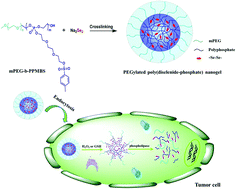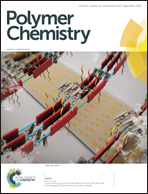PEGylated poly(diselenide-phosphate) nanogel as efficient self-delivery nanomedicine for cancer therapy†
Abstract
A redox-responsive PEGylated poly(diselenide-phosphate) nanogel with biocompatibility and biodegradability has been designed and prepared. Firstly, monomethoxy poly(ethylene glycol) (mPEG) was used to initiate the ring opening polymerization (ROP) of the cyclic phosphate monomer 2-(2-(2-(4-methyl-benzene-sulfonate)-ethoxy)ethoxy)ethoxy-2-oxo-1,3,2-dioxaphospholane (MBS-EEEP) to produce a diblock copolymer with 4-methylbenzenesulfonate (MBS) side groups in the block of polyphosphate. Then, the nanogel with a polyphosphate core cross-linked by many hydrophobic diselenide bonds and a hydrophilic PEG shell was obtained by using sodium diselenide as a crosslinking agent to react with the MBS side groups in the diblock copolymers. Dynamic light scattering and transmission electron microscopy measurements reveal that the nanogel has a spherical morphology with an average diameter of 150 nm. The systematic evaluation in vitro demonstrates that the nanogel can be endocytosed easily by tumor cells, and potently inhibit the proliferation of the tested cancer cells, with only slight cytotoxicity to normal cells. After 48 h incubation, the 50% growth inhibitory concentration (IC50) of the nanogel against the three tested cancer cell lines ranges from 12 to 16 μg mL−1. The remarkable anticancer efficacy might be ascribed to the active selenium species released from the nanogel in the presence of over expressed reactive peroxides and GSH within cancer cells. Besides its inherent anticancer ability, this nanogel may encapsulate other hydrophobic anticancer drugs for a cocktail therapy.


 Please wait while we load your content...
Please wait while we load your content...